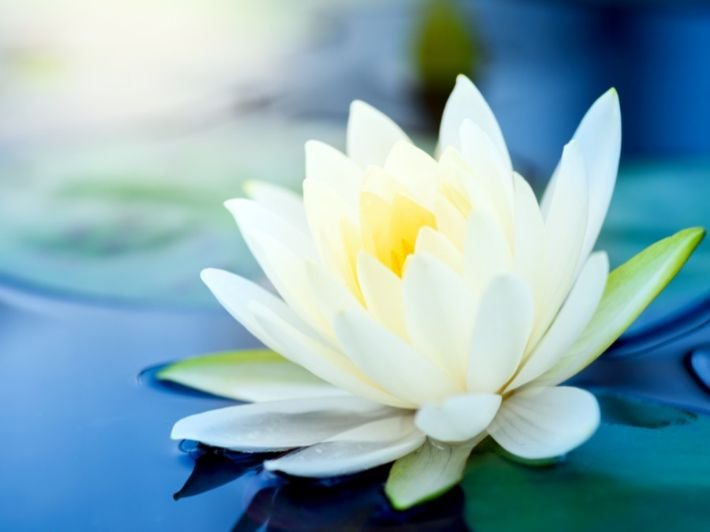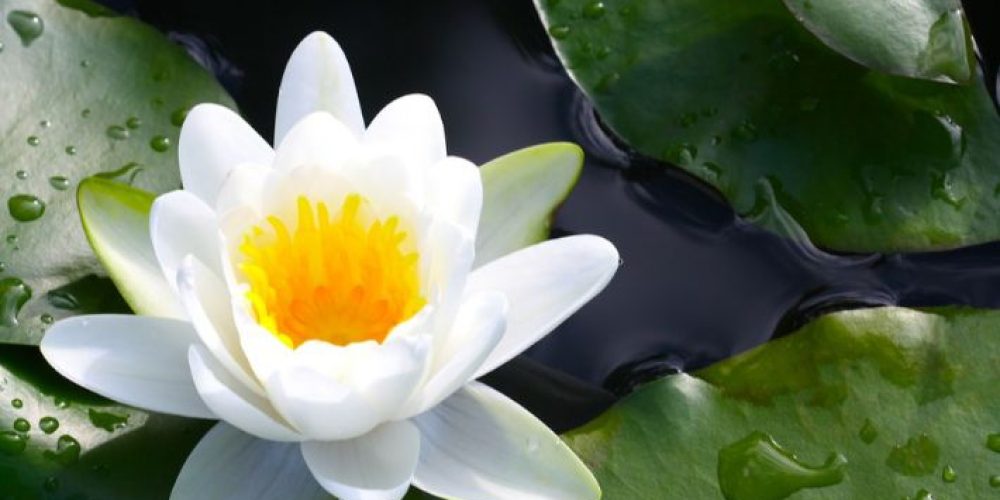Table of contents of the article
ToggleThe lotus flower, with its unique beauty and floating leaves, symbolizes purity and renewal in many cultures, and this enchanting flower adds a touch of magic and spirituality to any landscape.; On the World of Plants website, we defined the lotus flower, then we determined its original habitat, then we identified the types of lotus flower that are most suitable for home cultivation, then we explained the methods of growing the lotus flower and how to care for it, and many other matters related to the lotus flower that the reader of our site is interested in. The generous one.
Introduction to the lotus flower
The lotus flower (in English: Water lily) belongs to the Nileaceae family.
The original home of the lotus flower
Australia and Southeast Asia are the original home of the lotus flower.
Types of lotus flower most suitable for home cultivation
Dwarf lotus species, such as the sacred lotus “Momo Bhutan” (Nelumbo “Momo Bhutan”), are best suited for indoor home cultivation.

Methods of growing lotus flower
First: How to plant lotus flower tubers
This method is done by following the following steps:
- A waterproof planting container is used, that is, without drainage holes.
- Fill the pot with soil by 10 cm.
- The soil is watered in a small amount that is sufficient to moisten it without increasing the water.
- The tubers are placed on the surface of the soil, then fixed and covered with soil by 10 cm, keeping the growth tips of the tubers facing upward, as they must remain a small distance above the surface of the soil, with the rest of the tuber planted under the soil.
- The soil is covered with a thin layer of sand or gravel, to preserve the location of the tubers, and so that the water remains muddy when irrigating the planting pot.
- The tubers are watered with plenty of water until the ends of the tubers are completely covered, and placed in a sunny place.
Second: How to grow the lotus flower from seeds
This method is done by following the following steps:
- The pot is used to plant at a depth of 25 cm. It is filled with 5 cm of nutritious soil, then the soil is watered 10 cm above its surface, then the pot is placed in a warm, sunny place.
- Cover each seed to be planted with a ball of clay, gently hold it until it is planted in the soil, then add warm water so that it is 10 cm above the surface of the soil.
- The top of the planting pot is covered with plastic to warm the soil, and the pot is placed in a sunny place with an average temperature of 20 degrees Celsius, until the seeds germinate and grow.
- Plants are transferred to separate planting containers when seeds grow and leaves appear, and this process usually takes 10 days.
- Plants are fed throughout the growing season to obtain excellent results. Fertilizer is fed in quantities that are proportional to the sizes of the planting containers, and depend on the vitality of the plant.
Third: How to plant lotus seedlings
This method is done by following the following steps:
- A sunny area of land, garden, or basin is chosen in which the lotus flower is to be planted.
- The soil is transported to the place where you want to plant it, and it is watered with about 30-40 cm of water above the soil surface.
- Seedlings are planted after the soil absorbs water, and are installed in the appropriate place.
- It is preferable to cover the soil surface with gravel or stones to stabilize and consolidate the roots.
Preparing for planting lotus flower
1. How to extract lotus flower seeds and prepare them for planting
Seeds are extracted and prepared for planting in the following steps:
- The seeds are harvested after the petals fall from the plant, taking care not to leave the pods containing the seeds for too long so that they do not become too dry.
- The pods containing the seeds are harvested and stored in a paper bag, and placed in a dark, well-ventilated place, where the temperature is above freezing.
- Leave the pods in the bag for 3 to 4 days, or until they dry and become brittle. It is necessary to make sure that the pods are dry because they will rot if they are wet.
- Open the pods with your fingers, rub them gently to separate the seeds from the rest of the plant, then carefully select the seeds after placing them through a sieve.
- When planting, it is necessary to scratch the seeds. Without this process, they will not grow. This can be done using pliers, so that the brown layer surrounding them is eliminated, and an ivory color appears, while being careful not to peel them all the way to the pulp so that the seed does not rot and grows properly.
- The seeds are soaked in fresh water in a bowl, after which the seeds are gently transferred for planting.
2. The most appropriate times for planting the lotus flower
It is preferable to plant the lotus flower in the spring, as it requires relatively high temperatures and good sunlight. If it is planted in the winter, it is important to keep it indoors at warm temperatures.
3. Soil characteristics suitable for growing lotus flower
The lotus flower needs soil with a pH ranging from 6.5 to 8.0. Topsoil or clay can be used, taking care to stay away from soil that contains algae or a lot of organic matter, the abundance of which leads to rotting of seeds or tubers. A mixture of With 80% of clay or topsoil, with 20% of compost.11
Watering the lotus flower
Lotus flower irrigation dates
It is necessary for the edges to remain enriched with water as it evaporates, and it is preferable for watering to be done daily or every two days.
Ways to water the lotus flower
There is no specific way to water the lotus flower, and it can be watered through a tap.
Quantities of lotus flower irrigation
The lotus flower must grow in water with a depth ranging from 5 cm to 12 cm, and the water must remain floating on the surface with at least 5-10 cm of water.
Caring for the lotus flower after planting
Fertilizers that stimulate lotus flower growth
Slow-release commercial fertilizer tablets are used, which are purchased from commercial centers and then planted under the soil. The application of fertilizer depends on the amount of soil in which the lotus flower is planted.
Diseases that may affect the lotus flower and their treatment
We mention below some diseases that may affect the lotus flower:
- Plant sap-sucking pestsThese pests are caused by insects that suck the sap of many aquatic plants, including the lotus flower plant. The winged aphids feed on the upper leaves of the lotus plant, causing them to wilt or wrinkle, and turn yellow in color. They secrete a sticky substance on the plant leaves that promotes the growth of sooty mold that It leads to blackening of the leaves.
- Root lesionsThese pests are caused by insects that harm the roots and stems of the lotus plant, and on the flower buds, as they dig the stems of the plant and transmit fungal infections. These insects also cause the lotus plant to wilt, change its color, and eliminate its vitality.
- Leaf-eating pestsThese pests are caused by the larvae of the water lily beetle, which concentrate in the leaves of the lotus plant and spread throughout all parts of the plant. They also burrow into the leaves and leave brown marks.
Lotus flower treatments for diseases
- Remove sucking pests from lotus leaves with a strong spray of water.
- Cleaning the sticky traces left by insects.
- Use of pesticides such as; Bacillus thuringiensis, the entomopathogenic bacterium that effectively controls larvae.
- Periodically get rid of infected plant parts and clean the fallen remains to eliminate the breeding and spread of various pests.
How to harvest lotus flower
Lotus flowers are harvested in early autumn when the flowers fall. The stems are cut, and the seeds are collected so that they can be planted at a later time. There are some species whose roots can be eaten and are edible in different types of dishes.
Tips for caring for lotus flower
Below we list the most important tips for taking care of the lotus flower to keep it looking healthy and bright:
- Get rid of old flowers and leaves and prune the plant periodically.
- It is preferable to plant the lotus flower in loamy soil rather than in a container or pond.
- It is recommended to grow lotus from seed, due to genetic variability and the high percentage of seedlings that do not flower.
In conclusion, we would like to note that we, at the world of plants website, offer you all the necessary services in the world of plants, we provide all farmers and those interested in plants with three main services::-
- Artificial intelligence consulting service to help you identify diseases that affect plants and how to deal with them.
- Blog about plants, plant diseases and care of various crops ... You are currently browsing one of her articles right now.
- An application that provides agricultural consultations to clients, as well as a service for imaging diseases and knowing their treatment for free – Click to download the Android version from Google Play Store، Click to download the IOS version from the Apple App Store.
References
How to grow a lotus flower: your comprehensive guide - Roses and Flowers website




